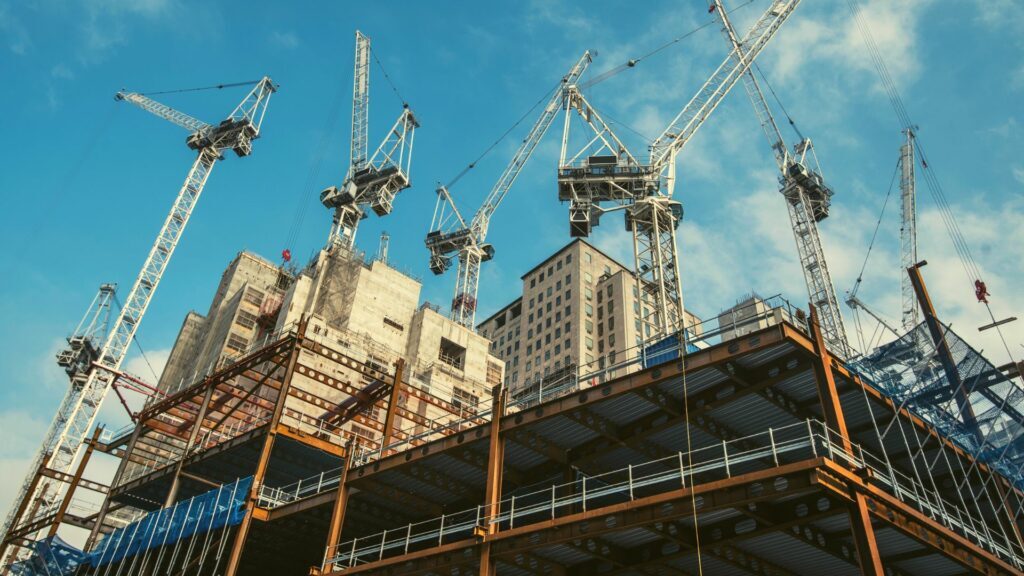
Building the Future: 7 Eco-Friendly UK Commercial Construction Trends
10 June 2024 By Falmouth Fairfax
In an era where sustainability is at the forefront of global consciousness, the construction industry is undergoing a significant transformation. In the UK, commercial construction is embracing eco-friendly practices to mitigate environmental impact and create buildings that are not just structures, but great examples of a greener future. On the Lanview blog today we explore seven trends shaping eco-friendly commercial construction across the UK.
Passive Design and Energy Efficiency: Passive design principles prioritise natural heating, cooling, and lighting to reduce energy consumption. Commercial buildings in the UK are increasingly integrating features like efficient insulation, high-performance windows, and orientation optimisation to harness natural light and heat.
Green Roofs and Living Walls: Green roofs and living walls are becoming popular solutions for enhancing building sustainability. Not only do they provide insulation and reduce urban heat island effects, but they also contribute to biodiversity and air quality improvement. Commercial buildings are incorporating these features to not only meet environmental standards but also create aesthetically pleasing and functional spaces.
Renewable Energy Integration: From solar panels to wind turbines, integrating renewable energy sources into commercial construction projects is a growing trend in the UK. Developers are harnessing the power of renewables to reduce dependency on fossil fuels and decrease carbon emissions. By generating clean energy on-site, buildings can achieve greater energy autonomy and contribute to the overall transition towards a low-carbon economy.
Sustainable Materials and Construction Techniques: The choice of materials and construction techniques plays a crucial role in determining a building’s environmental impact. UK commercial construction is increasingly prioritising sustainable materials such as recycled steel, reclaimed wood, and low-impact concrete alternatives. Additionally, innovative construction methods like modular construction are gaining traction for their efficiency and reduced waste generation.
Water Conservation Strategies: With water scarcity becoming a pressing issue globally, commercial construction projects in the UK are implementing water conservation strategies. This includes the installation of water-efficient fixtures, rainwater harvesting systems, and greywater recycling technologies. By reducing water consumption and promoting responsible usage, buildings can minimise their environmental footprint and contribute to water resource conservation efforts.
Smart Building Technology: The integration of smart building technology is revolutionising how commercial buildings are designed, constructed, and operated. From advanced energy management systems to IoT-enabled sensors for optimising resource utilisation, smart technologies enhance efficiency, comfort, and sustainability. By leveraging data-driven insights, buildings can adapt to occupants’ needs in real-time while maximising energy and resource efficiency.
Certifications and Standards Compliance: Certifications such as BREEAM (Building Research Establishment Environmental Assessment Method) and LEED (Leadership in Energy and Environmental Design) are guiding the UK commercial construction industry towards higher sustainability standards. Developers are increasingly seeking certification for their projects to demonstrate environmental responsibility, enhance market competitiveness, and meet regulatory requirements.
The shift towards eco-friendly commercial construction in the UK reflects a collective commitment to building a more sustainable future. By embracing passive design principles, renewable energy integration, sustainable materials, and innovative technologies, commercial buildings are not only reducing their environmental footprint but also setting new benchmarks for efficiency, resilience, and occupant well-being. As these trends continue to evolve, they promise to shape a built environment that is both environmentally responsible and economically viable for generations to come.
Source: Becky Freeman for Lanview
